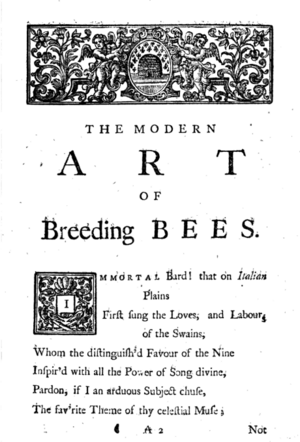Joshua Dinsdale facts for kids
Joshua Dinsdale was a writer who lived a long time ago, in the 1700s. He wrote many different things like poems, short books called pamphlets, and translations of other people's works. We don't know a lot about his life, but we do know he had a special university degree called a Master of Arts. He might have even been a clergyman, which is like a priest or minister.
Writing About Nature
In 1740, Joshua Dinsdale published two poems that were inspired by a famous Latin poem called Praedium Rusticum. This Latin poem was all about farming and country life, and it was very popular back then.
- One of Dinsdale's poems was called The Dove-Cote or, the art of breeding pigeons. It was about how to raise pigeons.
- The other poem was The Modern Art of Breeding Bees. This one was about beekeeping.
Dinsdale's bee poem even mentioned Virgil, a very old Roman poet who also wrote about bees. This showed that Dinsdale was part of a tradition where English writers imitated famous classical works.
Later Works and Translations
After these first poems, Dinsdale started writing for popular magazines like The London Magazine and The Scots Magazine. He wrote poems, reviews, and more translations. Some of his translations were from Latin poems by a Polish writer named Maciej Kazimierz Sarbiewski.
His last known works in The London Magazine were in 1751. However, two more of his translations were published the next year.
- One was Parmenides Prince of Macedonia. This was a translation of a French novel.
- The other was a translation from Greek of The Orations and Epistles of Isocrates. Isocrates was a famous speaker and teacher from ancient Greece.
When Dinsdale translated Isocrates's work, he tried to make it accurate but not too word-for-word. People later said it was a good translation, but it didn't have a very fancy writing style. The book mentioned that a "Rev. Mr. Young" helped revise it. This might mean Dinsdale had passed away by the time it was published.


